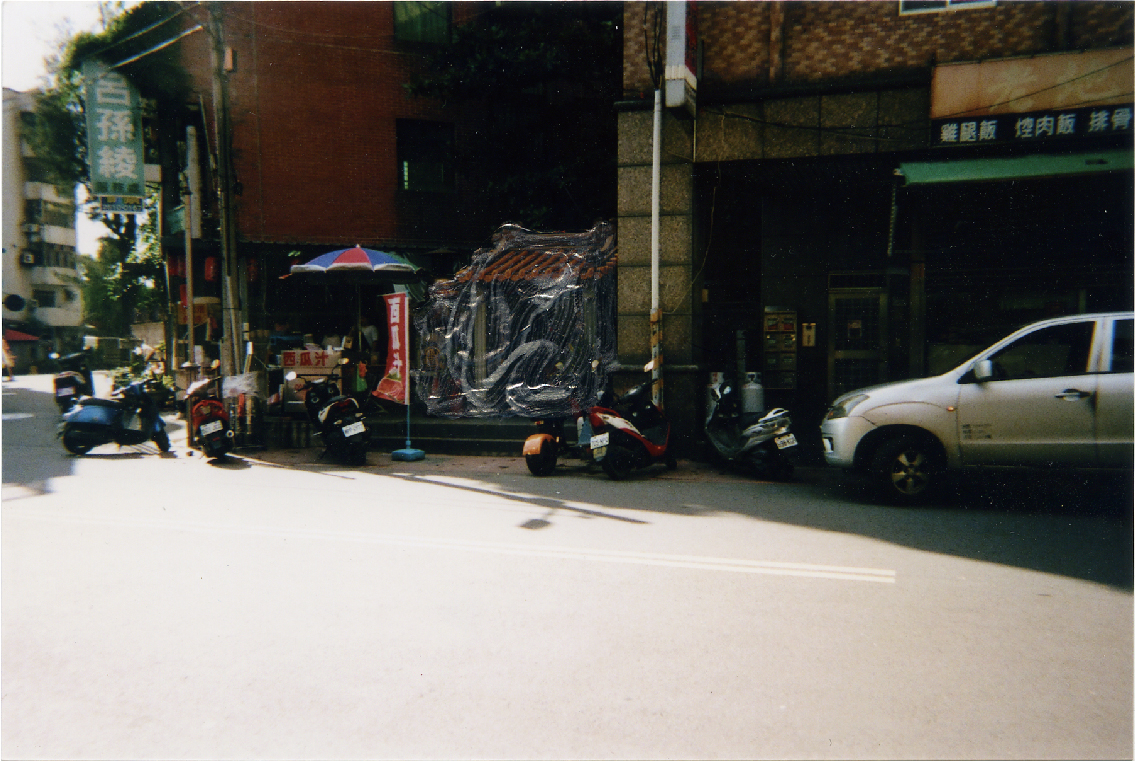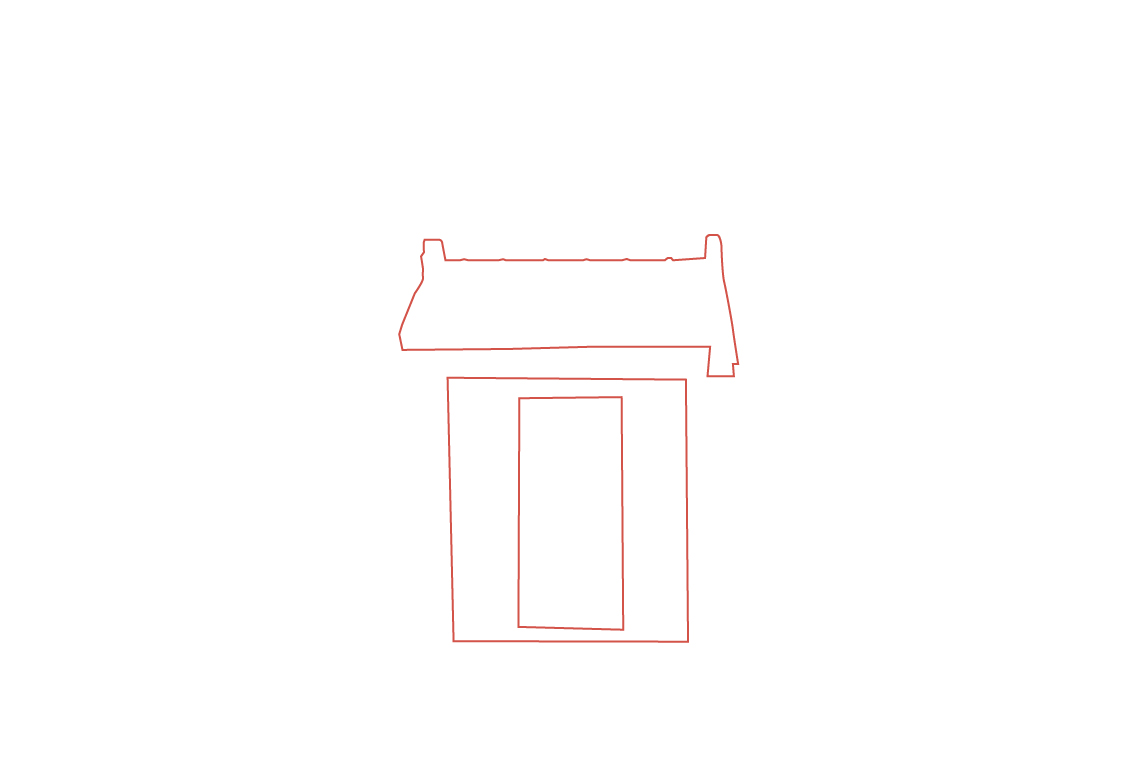







































安居的結構
Structure to Live in Peace
2019
影像輸出於棉紙
27 x 42 公分,共42件
影像輸出於棉紙
27 x 42 公分,共42件
卡爾維諾在《看不見的城市》中描述了兩座城市─優薩匹亞( Eusapia )和勞多米亞( Laudomia ),前者是雙子城,後者則是三重的城市。雙子意味著居民為了死後的自己建造了一座與生者之城一模一樣的城市,死者在此延續著他們生前的活動。勞多米亞除了和優薩匹亞一樣有著屬於亡靈的城市,還有第三個勞多米亞,是為了尚未誕生的人所建,現世的人總熱切的詢問著自己的未來,無論是聲望或是醜聞。
人們總是會去想像死後的生活與歸屬,如何才能「入土為安」,縱使塵歸塵、土歸土,我們卻總是不希望僅此而已,一連串的儀式與信仰由此而衍生。對於無主屍骨,撿者則祐,棄則遭殃,基於對無名力量的畏懼,幽魂也因此有了物質上的歸屬。背山面海的八里,經年累月成為人們的死後之城,就連無名的幽魂,也順著水流來到出海口,在現世居民的開墾、都市發展下出土,就地建造了「家」。沒有姓名只有通稱:萬應公、萬聖公、百姓公、聖公媽,只需平實的屋頂與低矮的柱子,遮風避雨處,即是歸屬的所在。
在〈安居的結構〉這個計畫中,我考察了八里地區的陰廟,拜訪各個場址並做記錄。洗出來後發現拍攝的照片是非常具資料性的,於是我試著直接對照片進行塗畫,試圖召喚我身處在現場時的身體,以及所感受到的時間遲滯與凝結,最後再將照片掃描。塗畫所用的膠,在掃瞄機的反射下得到像是膜一般罩住廟宇的影像。陰廟以類似家屋的形象被建立出來,然而它又不是家屋;具備祭拜的功能卻也不是廟宇,介於神的家與人的家之間,似乎是未完成的(對於廟宇而言),同時也是停滯不前的(對於人而言)。我畫出建物的基本結構─屋頂與柱子─作為未完成家屋的素描。
In "Invisible Cities," Calvino describes two cities: Eusapia and Laudomia. Eusapia is a twin city, while Laudomia is a triple city. The twin city means that the inhabitants have built an exact replica of the living city for their deceased counterparts, where the dead continue their activities from when they were alive. Laudomia, in addition to having a city for the souls like Eusapia, has a third city built for those yet to be born. The living inhabitants are always eager to inquire about their future, whether it concerns fame or scandal.
People often imagine their life and belonging after death, seeking how they can "rest in peace." Even though dust returns to dust, we don't want it to end there; thus, a series of rituals and beliefs arise. For the unclaimed remains, keeping them brings blessings, while abandoning them brings misfortune. Based on the fear of nameless forces, even ghostly spirits gain a material belonging. The coastal region of Bali, with its backdrop of mountains and sea, has become a city for the dead over the years. Even nameless spirits, carried by the water to the estuary, find a "home" unearthed through the development and reclamation of the living residents. They have no names, only common titles: Wanying Gong, Wansheng Gong, Baixing Gong, Shenggong Ma. A simple roof and low pillars provide shelter from the wind and rain, creating a place of belonging.
In the "Structure to Live in Peace" project, I examined the yin temples in the Bali area, visited various sites, and documented them. Upon developing the photographs, I found them to be highly documentary. So, I tried painting directly on the photos, attempting to summon the physical presence and the sense of time's delay and stagnation I felt on-site, then scanned the photos again. The adhesive used in the paintings created a film-like effect over the temple images when reflected in the scanner. Yin temples are built in the image of houses but are not houses; they serve a worship function but are not temples. They lie between the homes of gods and humans, seemingly unfinished as temples and stagnant as homes. I drew the basic structures of these buildings—roofs and pillars—as sketches of unfinished homes.
人們總是會去想像死後的生活與歸屬,如何才能「入土為安」,縱使塵歸塵、土歸土,我們卻總是不希望僅此而已,一連串的儀式與信仰由此而衍生。對於無主屍骨,撿者則祐,棄則遭殃,基於對無名力量的畏懼,幽魂也因此有了物質上的歸屬。背山面海的八里,經年累月成為人們的死後之城,就連無名的幽魂,也順著水流來到出海口,在現世居民的開墾、都市發展下出土,就地建造了「家」。沒有姓名只有通稱:萬應公、萬聖公、百姓公、聖公媽,只需平實的屋頂與低矮的柱子,遮風避雨處,即是歸屬的所在。
在〈安居的結構〉這個計畫中,我考察了八里地區的陰廟,拜訪各個場址並做記錄。洗出來後發現拍攝的照片是非常具資料性的,於是我試著直接對照片進行塗畫,試圖召喚我身處在現場時的身體,以及所感受到的時間遲滯與凝結,最後再將照片掃描。塗畫所用的膠,在掃瞄機的反射下得到像是膜一般罩住廟宇的影像。陰廟以類似家屋的形象被建立出來,然而它又不是家屋;具備祭拜的功能卻也不是廟宇,介於神的家與人的家之間,似乎是未完成的(對於廟宇而言),同時也是停滯不前的(對於人而言)。我畫出建物的基本結構─屋頂與柱子─作為未完成家屋的素描。
In "Invisible Cities," Calvino describes two cities: Eusapia and Laudomia. Eusapia is a twin city, while Laudomia is a triple city. The twin city means that the inhabitants have built an exact replica of the living city for their deceased counterparts, where the dead continue their activities from when they were alive. Laudomia, in addition to having a city for the souls like Eusapia, has a third city built for those yet to be born. The living inhabitants are always eager to inquire about their future, whether it concerns fame or scandal.
People often imagine their life and belonging after death, seeking how they can "rest in peace." Even though dust returns to dust, we don't want it to end there; thus, a series of rituals and beliefs arise. For the unclaimed remains, keeping them brings blessings, while abandoning them brings misfortune. Based on the fear of nameless forces, even ghostly spirits gain a material belonging. The coastal region of Bali, with its backdrop of mountains and sea, has become a city for the dead over the years. Even nameless spirits, carried by the water to the estuary, find a "home" unearthed through the development and reclamation of the living residents. They have no names, only common titles: Wanying Gong, Wansheng Gong, Baixing Gong, Shenggong Ma. A simple roof and low pillars provide shelter from the wind and rain, creating a place of belonging.
In the "Structure to Live in Peace" project, I examined the yin temples in the Bali area, visited various sites, and documented them. Upon developing the photographs, I found them to be highly documentary. So, I tried painting directly on the photos, attempting to summon the physical presence and the sense of time's delay and stagnation I felt on-site, then scanned the photos again. The adhesive used in the paintings created a film-like effect over the temple images when reflected in the scanner. Yin temples are built in the image of houses but are not houses; they serve a worship function but are not temples. They lie between the homes of gods and humans, seemingly unfinished as temples and stagnant as homes. I drew the basic structures of these buildings—roofs and pillars—as sketches of unfinished homes.
Copyright
© 2016 - 2025 劉書妤 Shu-yu Liu